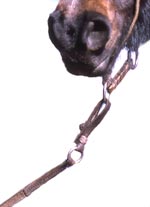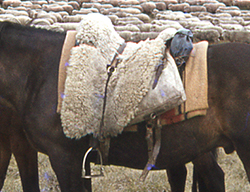The South American gauchos, brought to the Falklands to work the wild cattle have left a legacy of the Spanish/ criollo system of naming horse colours (and horse gear) accurately. Many words have been changed slightly to a Falklands version over the years.
|
Bosal (Spanish Bozal)
The 'halter' of Britain and North America. Essential piece of gear to which the caberesta (leading rein) attaches with a hide button. Shepherds would own several bosals perhaps of different sizes but always a main use and favourite one which was on his riding horse along with a cabesada (bridle) to which the reins attached. A second one was often in use at the same time for a leading or second horse. For work the bosal and caberesta was always used, a horse was rarely led by its reins. Bosals can be anything from intricate and plaited to plain, strong, hard doubled rawhide for 'posting' and working with wild unhandled colts. |
 |
Caberesta ( Spanish cabresto)
Leading rein made of rawhide with ring and rawhide button. Usually six or eight feet long. This attaches to the bosal. The bosal and caberesta are usually kept on the horse when riding and the caberesta will be held in the left hand along with the reins, hanging in a looser loop so that it does not interfere with the reins and bit. |
 |
Cabesada (Spanish cabezada)
This is the 'bridle' of Britain.
These attach to the bit by buttons and have a buckle for head size adjustment. Like bosals they vary from beautifully worked plaited or stitched designs to plain rawhide. |
|
Bastos
Saddle placed to be on a horse rug and secured with a cinch. Bastos are made of thick leather and stuffed. They were/ are made in the Falklands often by shepherds themselves. |
 |
Cinch and correón
Bastos are held on a horse's back with a cinch which is tightened and adjusted by a correóns which are a strips of hide perhaps one to two inches wide, and secured by a Falklands cinch knot. |
|
Maneas
Hobbles for horses, made of rawhide including the buttons. These were put on a horse in open camp or whenever a shepherd/ rider stopped or rested for a while to avoid the horse 'taking off' for home without him/ her. |
 |
Hide button
Hide buttons and knots are simple but extremely strong, they never break off or rust away like buckles tend to. There is no stitching to come undone either. |
 |
Cojinillo
Sheep skin that covers the bastos and cinch cinch. It is held on with a sobre (over) cinch. |
 |
Oilskins and maletas (saddlebags) are held in place with 'tientas' (leather thongs attached to the bastos). |
Sources: Pelajes Criollos- Emilio Solanet, Vocabulario Y Refranero Criollo- Tito Saubidet, Horse Color Explained- Jeanette Gower,The Color of Horses - Dr Ben K. Green, but mostly learned from Chris Perry |
    
|

